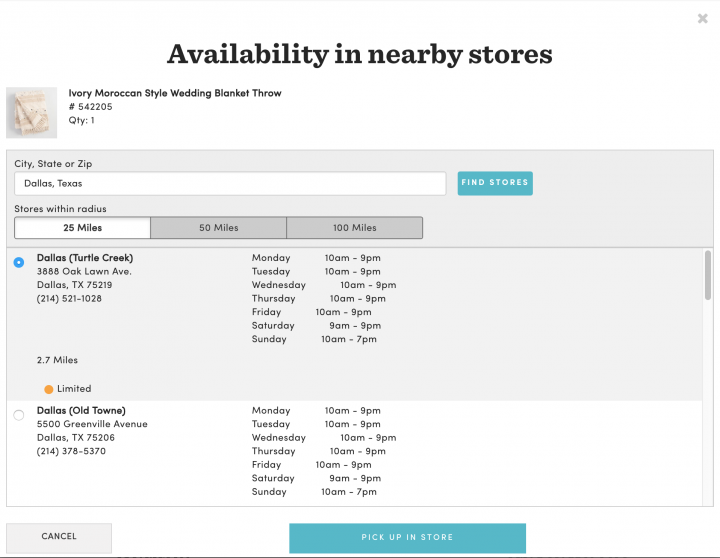The biggest brand in retail, Walmart, is continually announcing plans to further invest in technology to support buy online, pickup in-store, aka BOPIS — signaling that omnichannel fulfillment is an essential offering for retailers. But with shoppers’ convenience a prime imperative, merchants must accompany BOPIS with ultra-relevant promotions to drive supplemental in-store sales and long-term engagement.
Walmart’s latest move, announced earlier this month, will bring its gigantic automated pickup towers to 100 more locations after an initial pilot showed promising results. Shoppers scan a bar code stored on their phones at pickup tower kiosks to retrieve the items they ordered online, which are stored inside the machine.
The tower deployment follows Walmart’s decision last year to offer discounts on selected items ordered online and picked up in-store, and is further proof that the mega-retailer is willing to invest heavily to engage online/offline shoppers for omnichannel fulfillment.
The investment is no doubt based on consumers’ growing expectation that retailers with physical store outlets will offer an integrated omnichannel solution: Kibo’s 2017 Consumer Trends study found that not only do 78% of shoppers use BOPIS, but 49% are willing to remain loyal to brands offering the service. On the flip side, 55% will switch retailers if their preferred fulfillment method isn’t available, and 80% report they’re less likely to shop with a retailer whose website doesn’t provide information about local inventory availability.
Furthermore, shoppers expect BOPIS to be ultra-convenient and fast. More than half of shoppers said they used the service because they needed items that day, according to research by Bell and Howell, and 56% said a quick in-and-out experience was important when picking up orders.
Walmart is striving to meet those expectations for immediacy and convenience by placing their towers in the front of the store, with self-service functionality that completely circumvents pickup counters and their attendant lines. Together with Amazon’s recent (and decidedly mixed) experiments in checkout-free shopping, Walmart’s pickup towers represent a vision of the shopping future that is quick, convenient, and devoid of human interaction.
And therein lies the rub. Close to 60% of BOPIS users currently report making additional purchases in-store, according to Bell and Howell — but merchants fear frictionless experiences like Walmart’s that barely bring shoppers inside the store may jeopardize such add-on purchases. And automated processes that replace store staff endanger the one-to-one interactions that can foster sales and loyalty. More than four in five shoppers told Kibo they’ve been persuaded to complete purchases thanks to store associates equipped with mobile point-of-sale tools.
That doesn’t mean merchants should fight innovations that streamline buy online, pickup in-store fulfillment or, worse, manufacture a meandering pickup process in the hopes of luring shoppers into additional store purchases. A poor experience will only make any future brand interaction less likely.
Instead, merchants should deliver first and foremost on the promise of BOPIS convenience, and then capitalize on the positive experience with savvy promotions that encourage shoppers to return for further purchases.
To achieve that vision, merchants should:

1. Lay the foundation with the right technology. Integrated order management, eCommerce, and fulfillment systems that can serve shoppers nimbly whether online or in-store are key. A unified solution gives merchants maximum flexibility to integrate in-store information within the eCommerce environment, enable swift omnichannel fulfillment from store inventory, and connect mPOS-enabled associates with comprehensive customer history profiles, among other benefits.
Kibo merchant World Market integrates store information seamlessly into the eCommerce product page, enabling shoppers to view inventory status and store hours and choose a fulfillment location via a modal window.
2. Use personalization tools to deliver time-sensitive offers. We’ve discussed before how the benefits of personalization extend well beyond cross-sells and up-sells on the eCommerce site — and buy online, pickup in-store represents a ripe opportunity to reach existing customers with highly relevant offers, converting self-service pickup stops into additional store purchases. Based on order history and store pickup location, merchants can deliver:
- In-store coupons for items that complement the order, good for a limited time. Such offers can be delivered to mobile devices or included in BOPIS packaging.
- Invitations to attend store events or try in-store services such as personal shopping consultations.
- Real-time shopping alerts highlighting items of interest that are in low supply on the store shelves, new items in the customer’s preferred size or style that have just arrived in-store, or brands or products that are trending on social media and available in the store.
Learn more about how Kibo’s patented personalization technology delivers real-time insights to enable relevant promotions wherever customers shop.
3. Award BOPIS customers store loyalty points. Merchants should not only invite BOPIS customers to join loyalty programs, but they should consider using bonus points strategically to encourage subsequent return visits and purchases. As a starting point, sellers can offer bonus points to those who use in-store pickup as a means of passing along savings on last-mile delivery. Once BOPIS customers enroll, merchants can then promote further opportunities to re-engage and earn rewards, such as rating the store pickup experience, signing up for in-store events, or redeeming store-specific coupons.
How are you balancing the need to boost buy online, pickup in-store convenience with the opportunity to drive additional store sales?




